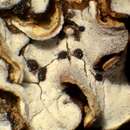fi
nimet breadcrumb-navigoinnissa


Life Habit: lichenized, not lichenicolous; Thallus: squamulose, attached by the whole lower surface or basal end of squamule; squamules: dispersed, adjacent, imbricate, or ascending, 2-10 mm wide, rounded to elongate, with entire, crenulate or lobed margin, vegetative dispersal units lacking; upper surface: from grayish or greenish to dark brown, sometimes red or yellow, dull or shiny, epruinose to densely white pruinose, smooth to deeply fissured; upper cortex: varying from 35 to 200 μm thick, containing remnants of algae (chlor-zinc-iodine!), consisting of an upper epinecral layer and a lower stainable layer, the latter composed of thick- to rather thin-walled, anticlinally oriented hyphae with shortly thread-like, angular, or round lumina, often containing lichen substances and/or calcium oxalate; algal layer: 40-80 μm thick, horizontally continuous; photobiont: chlorococcoid, algal cells 10-15 μm diam.; medulla: white, of intricately interwoven hyphae, I-, often containing lichen substances and/or calcium oxalate; lower cortex: poorly to well developed, composed of periclinally or anticlinally oriented hyphae, sometimes containing calcium oxalate or anthraquinones; lower surface: white to brown; Ascomata: apothecial, laminal or marginal, sessile, with a constricted base, simple or rarely somewhat conglomerate, usually convex and immarginate but often plane and indistinctly marginate when young, up to 2 mm diam., brown to black, dull to shiny, epruinose or with yellow or white pruina; exciple: annular, continuous with upper cortex, colourless to pale brown, composed of thick-walled, strongly conglutinated, radiating hyphae; hypothecium: colourless to pale brown, composed of intricately interwoven hyphae densely inspersed by crystals of calcium oxalate and sometimes lichen substances, I-; epithecium: brown, containing brown cell wall pigments and orange crystals of anthraquinones (mainly parietin) (polarized light!), K+ red; hymenium: hyalin, I+ blue, 60-100 μm high; paraphyses: straight, sparingly branched and anastomosing, strongly conglutinated, apical cell slightly swollen; asci: clavate, with a well developed, amyloid tholus containing a deeper amyloid tube and lacking an ocular chamber (Porpidia-type), 8-spored; ascospores: colourless, simple, ellipsoid, smooth, without halo; Conidiomata: pycnidial, laminal, immersed, with colourless or pale brown ostiole, with short, sparingly branched conidiophores; conidia: acrogenous, bacilliform; Secondary metabolites: anthraquinones, depsides, depsidones, fatty acids, pulvinic acids, triterpens, and usnic acids.
The genus is characterized by the squamulose thallus containing green, unicellular algae; lecideine apothecia; asci with amyloid tube in the tholus; simple, hyaline ascospores; presence of anthraquinones in the hymenium and calcium oxalate in the hypothecium; and immersed pycnidia with bacilliform pycnoconidia.
Arctic to subtropical regions of the world, highest diversity in arid zones.
Growing on soil and rock, often calciferous, in open habitats.
Anamylopsora (no amyloid reaction in the tholus; no anthraquinones in the hymenium), Eremastrella (no anthraquinones in the hymenium), Glyphopeltis (no anthraquinones in the hymenium, no calcium oxalate in the hypothecium), Psorula (no anthraquinones in the hymenium, no calcium oxalate in the hypothecium, sessile pycnidia with ellipsoid pycnoconidia), Romjularia (no anthraquinones in the hymenium, no calcium oxalate in the hypothecium, sessile pycnidia with ellipsoid pycnoconidia).
Psora is a genus of lichen-forming fungi in the family Psoraceae.[2] Members of the genus are commonly called fishscale lichens.[3][4] Lichens in the genus Psora are known to have a squamulose thallus and anthraquinones in the hymenium.[5]
Psora is a genus of lichen-forming fungi in the family Psoraceae. Members of the genus are commonly called fishscale lichens. Lichens in the genus Psora are known to have a squamulose thallus and anthraquinones in the hymenium.
Psora Hoffm. (łuszczak, krostowiec) – rodzaj grzybów z rodziny łuszczakowatych (Psoraceae)[1]. Ze względu na współżycie z glonami zaliczany jest do grupy porostów[2].
Pozycja w klasyfikacji według Index Fungorum: Psoraceae, Lecanorales, Lecanoromycetidae, Lecanoromycetes, Pezizomycotina, Ascomycota, Fungi[1].
Synonimy nazwy naukowej: Chrysopsora (Vain.) M. Choisy, Fritzea Stein, Lecidea sect. Chrysopsora Vain., Peltiphylla M. Choisy[3].
Nazwa polska według W. Fałtynowicza[2].
Nazwy naukowe na podstawie Index Fungorum[5]. Nazwy polskie według W. Fałtynowicza[2].
Psora Hoffm. (łuszczak, krostowiec) – rodzaj grzybów z rodziny łuszczakowatych (Psoraceae). Ze względu na współżycie z glonami zaliczany jest do grupy porostów.